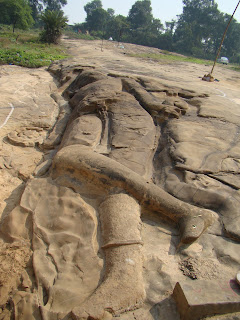Rock-cut Anantasäyi Vishnu (9th century CE) at Dhenkanal. Odisha
Odisha is fortunate to have a stupendous rock-cut image of Anantasäyi Vishnu in Dhenkanal district. The image is carved on a boulder on the bank of River Brähmani, in village Säranga, around five miles from Talcher town. The motive behind carving out such an unusual figure with the stamp of dynastic vitality, and forceful vigour was perhaps inspired by the rock-cut monuments of Ajanta (2nd century BCE - 7th century CE), Ellora (8th century CE), and Mahäbalipuram (6th century CE). This stupendous figure measuring 49’-10” from the head of Seshanäga (the Snake), to the heel of the deity is the largest image of its kind in reclining posture in India. The figure holds a chakra in its upper right hand (4’), a gadä in its lower right hand (8’-10”), a sankha in its upper left hand (5’-3”), and a symbolic padma in its lower left hand. From the navel of the image is carved a lotus, on which Brahmä (single-faced here) is seated. The chin is pointed, the nose is sharp and the nose prominent.
|
The measurement of different limbs of the figure i.e. 26’ from the hood of the serpent to its waist, 10’-1” from the chin to the top of the crown, and the ear with ornament having a length of 5’ are simply astonishing. The head of the deity is facing east, which apparently bestows peace in the region. Considering the relatively calm and contented disposition of people of Odisha, this cannot be denied. The depiction of kirita-mukuta on the head put this image in the later part of rule of Bhauma Dynasty in Odisha. However, the real purpose that prompted the builder to carve out such a colossal specimen out of a living rock on the banks of Brähmani River in a place without corroborative archaeological evidence, or antiquarian remains worth the name, is still shrouded in mystery. It is presumed that some devout Vishnu-worshipper created this gigantic figure out of living rock, in order to excel the large Buddhist statue of Ratnagiri, Lalitagiri and Udayagiri complex of Cuttack district.
I visited Anantasäyi Vishnu in Säranga, Talcher on 6th December 2009. I first came to about its existence in a local newspaper. Initially I thought it was a natural formation of the rock by the river. I enquired from many people, but got lukewarm response. Finally, ‘Sambäd’ carried a coverage about its possible destruction by the industrial exploration nearby. I wanted to see it before either of us were to vanish. I made it in 2009. It was an overwhelming experience, although it was difficult to photograph the whole figure. I climbed on the Government-made wall to photograph the whole figure. To click the ayudhas, one has to be careful so as to not step on the figure. I am still doubtful about the position of the sankha, chakra, gadä and padma. However, I have gone ahead with the official Gazette report. I may not be able to make another visit. |
I visited the Bhimakanda Anantasäyi-Vishnu also the same day, but do not want to upload the photo, or encourage anyone to see it. It is so badly placed inside the industrial area.
***






